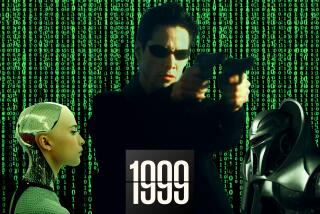BOOK REVIEW / NONFICTION : Illuminating Thoughts on Power of Artificial Intelligence : FLUID CONCEPTS AND CREATIVE ANALOGIES: Computer Models of Mental Fluidity and Creativity<i> by Douglas R. Hofstadter and the Fluid Analogies Research Group</i> , Basic Books, $30, 512 pages
- Share via
Disregard this book’s title, which is poor. The rest of the book is terrific--deep, wise, provocative and profound.
The subject is artificial intelligence--the effort to get computers to think like people. Douglas R. Hofstadter has been working in the field since 1977, and in this book he presents his highly original and creative conclusions.
Fifteen years ago, Hofstadter, a computer scientist at Indiana University, won a Pulitzer Prize for his book, “Godel, Escher, Bach,” an imaginative melding of logic, art and music. His latest book is no less an achievement. Note: Reading this book demands full attention, but the payoff is well worth it.
Since the 1950s, artificial intelligence has been the subject of considerable hype and minimal success. To be sure, computers can play chess better than all but a handful of people, but they cannot distinguish one face from another, which even a baby--or a dog--can do.
Computers cannot read a novel and summarize its plot. They cannot “get” a joke. Despite decades of effort by computer scientists, computers still cannot reliably translate written text from one language to another.
All of these tasks require “understanding,” which no computer has and which no one knows how to give them.
Computers can do mechanical tasks very well, which is not surprising, since they are machines. They are rigid and rule-bound.
But the real world of human experience is not rigid or rule bound. It takes judgment to distinguish one situation from another and to apply one rule in one case and a different rule in another. Computers have many strengths, but they do not have judgment.
In an effort to get a handle on artificial intelligence--a term he dislikes--Hofstadter explores what we mean by intelligence in the first place. Intelligence, he argues, is not a matter of amassing more and more facts. Intelligence is the ability to put facts together in a new way, to see connections and analogies. Humans can do this and machines cannot.
Hofstadter writes, “No true-life situation comes with hard-and-fast boundaries; all situations blur into myriad other situations and facts, and an important part of the act of analogy-making is the determination of where one situation ends and others start.”
It is this blurriness of real life that interests Hofstadter, and it is what he means by “fluid concepts” in the title of the book. All human situations are festooned with ifs, ands or buts. Humans understand them effortlessly. How do we do that?
Hofstadter says the central problem is figuring out “how people make sense of the vast amount of raw data constantly bombarding them from their environment.
“The essence of human perception lies in the ability of the mind to hew order from this chaos, whether this means simply detecting movement in the visual field, recognizing sadness in a tone of voice, perceiving a threat on a chessboard, or coming to understand the Iran-Contra affair in terms of Watergate.”
Most of the book is a series of case studies of various programs that Hofstadter and his colleagues have developed over the years in an effort to get computers to see patterns, make analogies and think creatively. Each of these is a monumental task.
For example, one chapter describes Hofstadter’s oldest project: getting a computer to figure out the next number in a series. Suppose you are given the sequence 2, 4, 6, 8 and are asked for the next number. Before too long, you come up with 10. How did you do that?
First, you recognized the rule. Each number is 2 more than the previous number. Or, perhaps you recognized this as the sequence of even numbers starting with 2. In any case, you have figured out the rule, and you apply it to come up with the next number, which is 10.
But suppose the sequence is a little harder:
1, 2, 1, 1, 2, 3, 2, 1, 1, 2, 3, 4, 3.
Figuring out the rule takes a fair amount of looking and going back and forth. It may be easier to see the answer if the sequence is broken into chunks:
1, 2, 1 / 1, 2, 3, 2, 1/ 1, 2, 3, 4, 3.
Now it’s clearer that the numbers ascend and descend, and each time the peak is one digit higher.
The next number in the sequence is 2.
How can you get a computer to figure out the rule? How does it know that it’s supposed to break up the sequence into chunks and that the chunks should be of varying lengths? How can you get a computer to look down an unfamiliar path? How can you get a computer to think creatively?
The book is filled with such problems and with the tantalizing observations about knowledge and intelligence that Hofstadter has gleaned in the process of attacking them.
“Analogy-making lies at the heart of pattern perception and extrapolation,” he writes. “What could be more obvious? And when this banality is put together with my earlier claim that pattern-finding is the core of intelligence, the implication is clear: Analogy-making lies at the heart of intelligence. . . . All the research in this book came from the detailed working-out of these ideas.”
This is a rare book. It illuminates every subject it touches.
More to Read
Sign up for our Book Club newsletter
Get the latest news, events and more from the Los Angeles Times Book Club, and help us get L.A. reading and talking.
You may occasionally receive promotional content from the Los Angeles Times.










